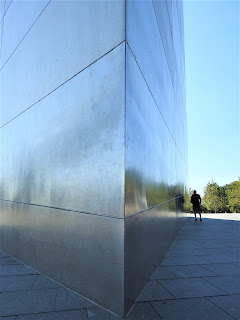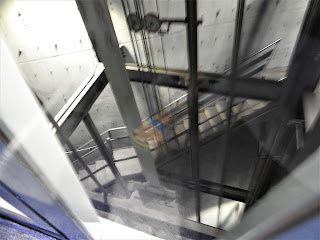We are actually camped in St. Charles, a pretty little town just NW of St. Louis. Our park is situated right next to a very tall railroad trestle and also under the approach to STL. How cool is that?!
 |
| train trestle next to the campground |
 |
| American Airlines? Or Amazon Airlines? |
We are chasing down another bucket list item: Rob has ridden the St. Louis arch, Lindy has
not. Yet.
The goal of the historians and dreamers was to create a monument in St. Louis that would symbolize the fact that it was where the pioneers gathered to depart for the unknown mysterious West. This was the node from which those emigrants launched. What type of monument could symbolize that, they wondered? The ideas of many artistic architects were solicited and many monument sketches were submitted but the obelisk was ruled out. It just didn’t convey the concept. Finally in 1948, the proposal of Eero Saarinen was enthusiastically accepted: an arch, an entry point, a “gateway,” as it were. And indeed, it stuck. The arch is now famously nicknamed, “The Gateway to the West.”
 |
| Rob at the base |
It was an enormous, herculean project, from the planning,
engineering and acquisition of materials (shipped from as far away as
Pittsburgh…steel) to the orchestration of the complex assembly process. In 1963, construction began. Tons of concrete were poured, giant cables
and wires were run and thick sheets were assembled and welded. The towers began to rise from both ends, 630
ft. apart, on 26,000 tons of concrete below the ground, section by section,
with the intention to meet at the top with the final piece. Hardhats worked at dizzying heights,
sometimes in tremendous wind and snow, while surveyors with lasers kept a
constant vigil. External trusswork and the
install of the last piece.
Full disclosure: Picture
plagiarized from our
book on the construction
of the arch.
When the height grew
such that it could no longer be reached by the tallest cranes, a network of
tracks was installed on the outside surface of the arch itself upon which the
next section moved upward. In the end,
the arch is comprised of 5,200 tons of steel and 12,100 tons of concrete inside
the arch and endless miles of cable. Each triangular section weighs on average 50 tons. On Oct. 28, 1965, the ceremonial day when the
final piece was put in place, thousand gathered 630 feet below to watch.
I had heard rumors about claustrophobia in the tight cars that transport people to the top but I don’t usually suffer from that so I was ready to roll. It turns out that the cars are not so small at all, although since it is not high season, Rob and I were the only occupants of our five-seater car that traveled up the north tower. The staff orchestrates the loading and unloading of the cars to the second. It takes only 4 minutes to rise to the top and there, we exited the car to a walkway where there are eight 27” X 7” windows, on either side. Through these windows, you can see forever! Ten minutes later, it was time to board the cars for the 3 minute descent. Bucket list item checked off. You are probably wondering who’s the poor bastard that has to wash the windows and how does he get up there?! Me, too.
 |
| The white arrow points out the windows at the top. |
 |
| Inside the car. |
 |
| Rob inside the car on the way up. |
 |
| Peering out the window at the top. |
 |
| Little doorway to car # 1 |
 |
| I haven't looked down at the top of a flagpole before now! |
 |
| All kinds of gov't-mandated social distancing and masking going on. We were instructed to stand on the blue dots. We stuck our feet outside the blue dots 3 times and nobody saw us! |
 |
| Soon we were behind "door number one." |
 |
| The innards of the arch as seen through our car window. |
 |
| A tug pushing a barge down the Missouri River, from 630 feet above terra firma. |
 |
| Hey! You can see the Budweiser Brewery from up here! |
Next was the movie theater to watch actual footage of the
assembly process. Just the movie looking
down from those heights and watching the hardhats at work with no harnesses gave
us a sickening, churning feeling. We
were relieved to learn that not a single life was lost on this project.
 |
Waiting to board the Tom Sawyer river boat |
My activities director, Rob, did a fantastic job orchestrating this day. We boarded the Tom Sawyer for a little cruise on the Missouri River in the warm afternoon sun. The site that was chosen for the arch was thought through well in this chick’s humble opinion. It is a fine sight to see right at the river’s edge. The old county courthouse is centered perfectly from certain angles. This courthouse was the venue in which Dred Scott lost his law suit to become a free man. His argument was that he had lived in free states (IL and the WI Territory) and by law could no longer be held in bondage as a slave. The case lasted 10 years and was appealed several times all the way to the US Supremes who also ruled against Dred Scott. This decision (1857) and Abe’s Emancipation Proclamation (1862) triggered our country’s Civil War. You are probably asking yourself why Mary Bateman Clark won her case and her freedom in 1821, right? Here’s the answer: It happened in Indiana, a free state, at the state Supreme Court level. Her case never got as far as the Nine Men In Black, lucky for her!
 |
| The Old St. Louis County Courthouse and the arch as seen from the water. |


Outstanding!!!
ReplyDeleteThanks for bringing back some fond memories of the Arch.
We were there long long ago, but with only fond memories.
Thanks for your pictures and narrative.
Happy Traveling.
F & L
i have been in St Louis several times but never had time to take the trip up the arch. My bad.
ReplyDeleteNo kidding, "Your BAD!" This is not something to be missed! Be sure to see the movie, too!
DeleteSt. Louis is one of my favorite bigger cities in the Midwest. It had been since my first time there in 1963 on our way to Des Plaines. We spent the night there at a convent. There is so much to see and do there.
ReplyDeleteI was remembering that....
DeleteThat was really interesting!!!
ReplyDeleteNow on our bucket list 🙂
ReplyDeleteYou're such a rebel...stepping out of the circle 3x ;) Great day!
ReplyDelete